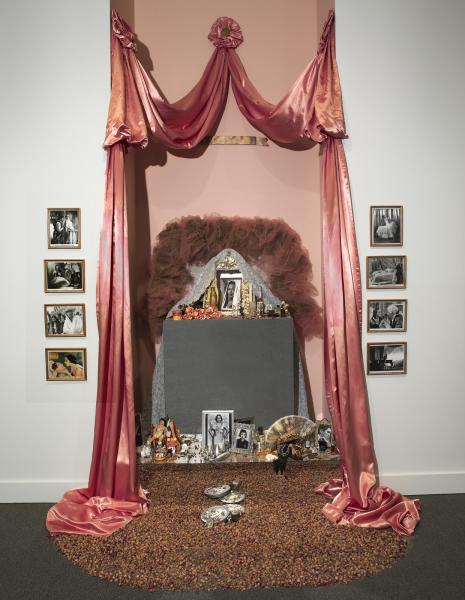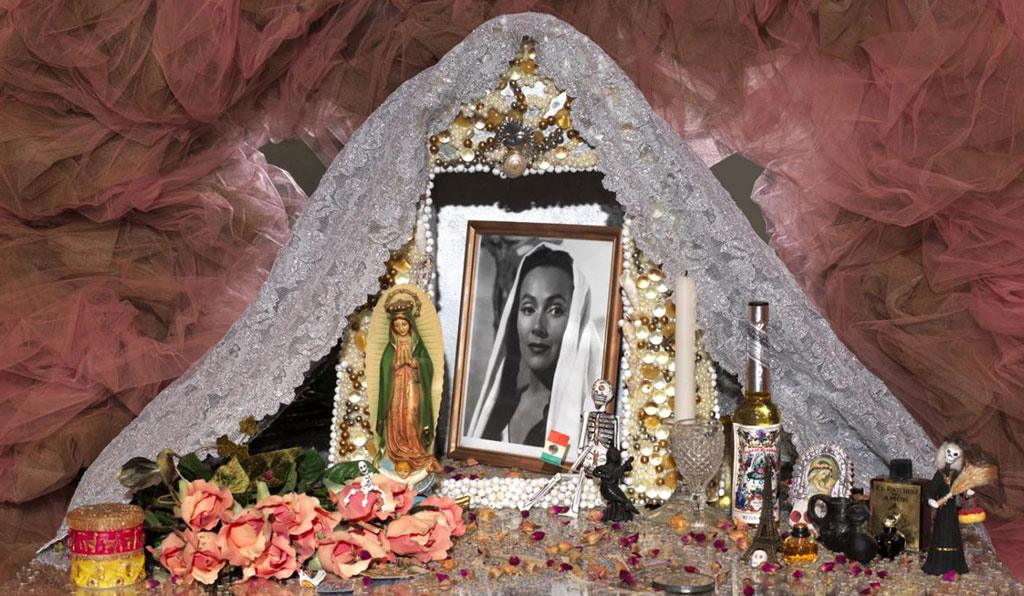The Chicano Movement gave rise to a Chicano cultural identity with which many Mexican Americans associate themselves to this date. It constitutes a unique mixture of both American and Mexican cultural aspects which shape its basis. The Chicano culture is the result of the American Mexicans’ experiences and their ability to retain their traditional practices while living in an environment which is dominated by people of a different language and ethnicity. Art plays one of the essential roles in the Chicano culture and manifests itself in various forms, including sculpture, murals, paintings, and even novels which are often based on the ideas of community and activism. Rasquachismo aesthetic is an integral part of the Chicano culture which is extremely popular in the community and utilized by many individuals. It stems from the Spanish word “rascuache,” which has been used for many decades as a derogatory term for the visual culture of low-income Mexicans (Cooper, 2018). The artwork “An Ofrenda for Dolores del Rio” by Amalia Mesa-Bains is an example of the Rasquachismo aesthetic, which can be analyzed to establish its key features.
Before starting the analysis of the piece, it is important to introduce some background information concerning the artist behind it. Amalia Mesa-Bains is famous for her both artistic and academic works dedicated to exploring the Chicano aesthetic, its history, and essence. Over the years, she exhibited at many venues, including international ones, and received numerous awards for her art pieces. Her works often feature autobiographical objects, as well as items which are popular among the members of the Mexican community. Yet, in the case of the Rasquachismo style, the authorship of artwork bears no significant relevance since it always reflects a larger context which goes beyond the artist’s characteristics. According to Mesa-Bains herself (2019, p 92), Rasquachismo constitutes for “Chicano artists and intellectuals a vehicle for both culture and identity.” Therefore, Rasquache artwork can be viewed not simply as a creation of one particular artist filled with their ideas but rather as a manifestation of the community values relevant for the Chicano culture. In other words, every Rasquache piece is instantly recognizable as one, and the authorship plays only a secondary role.


This idea can be observed in “An Ofrenda for Dolores del Rio,” namely, in the theme, it is dedicated to. Dolores del Rio was a renowned Mexican actress who was admired by the members of the Chicano community since they felt that they shared the same identity with her. Certainly, Mesa-Bains her relationship with the actress and her own experiences with her movies and del Rio herself, which enabled her to create this installation. Yet, this altar can be easily imagined sitting in the house of an ordinary Chicano woman who was inspired by the actress’s acting and beauty and decided to honor del Rio’s memory. Such universal nature of this particular artwork can be attributed to the Rasquache aesthetic and the aspects of this style and its features which make it an expression of the Chicano identity. The primary element of the installation is the “ofrenda,” or the altar which can be seen in many Mexican households during the Day of the Dead. This element, together with other home altars, have become integral for the Chicano community and the art of its members.
Another aspect of the Rasquache aesthetic which is relevant for “An Ofrenda for Dolores del Rio” is the biculturalism which constitutes the essence of the Chicano culture and the source of inspiration for Chicano artists. Mesa-Bains mixes objects which have different legacies and represent different cultures, namely, the Mexican and American ones, and, by being featured together in one installation, they form a unique and spectacular ensemble. For example, the altar contains traditional day-of-the-dead figurines, a copy of the Mexican flag, a bottle of Mexican liquor, and at the same time, it features U.S (Figure 2). dollars and Hollywood film reels. The altar also has mass-produced items such as an Eiffel Tower trinket and perfumes, which symbolize American consumerism. This approach is common for the Rasquache aesthetic and constitutes the ability of the members of the Chicano community to fuse parts of different cultures. According to Tomás Ybarra-Frausto (2019, p. 86), Rasquachismo “has evolved as a bicultural sensibility among Mexican Americans”. The altar by Mesa-Bains reflects this idea by incorporating elements of the American and Mexican cultures and making them represent the Chicano identity.
Another important factor of the Rasquache aesthetic is the materials sourced by artists and ordinary members of the Chicano community to create their pieces of visual art or to simply decorate their houses and spaces. As noted by Amalia Mesa-Bains (2019, p. 92), “In Rasquachismo, the irreverent and spontaneous are employed to make the most from the least.” Thus, the Rasquache aesthetic principles imply that the objects created by people do not have to feature any rare and expensive materials or done by experts who spent half of their life perfecting their skills. In “An Ofrenda for Dolores del Rio,” Mesa-Bains does not utilize any extraordinary items, instead, she uses objects such as flowers, a hand fan, a photograph, and a statuette of the Virgin Mary (Figure 1). Rasquachismo rejects the notion that art and beauty can be made only by a small group of individuals recognized as artists. Instead, it empowers ordinary people to explore the themes they are passionate about with the means available to them and feel proud about their work.
When put together, these objects create a whole which is perceived as coherent, unified, and aesthetically pleasing despite the fact that the altar consists of small unrelated pieces. “An Ofrenda for Dolores del Rio” perfectly illustrates the spirit of Rasquachismo and the unrelenting desire of the Chicano community to adorn their environment and fill it with meaning. This can manifest itself in murals which highlight political issues or drawings on a car which depict the owner’s ideas. Another essential element of the Rasquache aesthetic, according to Tomás Ybarra-Frausto (2019, p. 86), is the “profusion of textures and colors and a jumble of things.” The purpose of this abundance is to attract the attention of the people who view the Rasquache artwork by causing them to become interested in the peculiar interplay of colors and objects. Similarly, the altar by Mesa-Bains invites the audience to study it and draw connections between the life and legacy of Dolores del Rio and the items featured in the installation. The author’s idea here is to enable the viewers to interact and engage with the piece.
Rasquachismo is a style which is unique because it evolved to be a tool of the disenfranchised community, which helps present the attitudes and concerns of its members. When comparing it to kitsch, Mesa-Bains stated that Rachismo functions as the foundation of Chicano cultural identity while its counterpart has only material value. One of the objects from “An Ofrenda for Dolores del Rio” can help explain this concept more clearly. Mesa-Bains features in her installation an Eiffel Tower, which, if perceived separately, is an example of kitsch, yet when immersed in the context of the artwork, it gains new meanings. It becomes clear that the artist put it near the portrait of Dolores del Rio to symbolize fashion and glamour, which are often associated with Paris, the city where the original Eiffel Tower is placed. Thus, in Rasquachismo, the value is placed on everyday objects which are repurposed to obtain significance in new contexts. This demonstrates the inventiveness and ingenuity of the Chicano culture and the people who belong to it.
“An Ofrenda for Dolores del Rio” by renowned artist and scholar Amalia Mesa-Bains represents a perfect example of Rasquachismo, an aesthetic which is an integral part of the Chicano identity. It is a clear manifestation of the Chicano culture and the people who associate themselves with it since it demonstrates their enthusiasm and attitudes towards various phenomena. The artwork in question contains many features of Rasquachismo. For example, it features a mix of objects which are unrelated to one another, but when viewed together in the context of the altar, they gain meaning and coherence. Another element of the aesthetic relevant to Mesa-Bains’s piece is biculturalism, which is shown through items which traditionally belong to Mexican and American cultures. In “An Ofrenda for Dolores del Rio,” the artist managed to capture the Chicano sensibility and design an artwork which follows the principles of the Rasquache aesthetic.
References
Cooper, K. (2018). We should all be celebrating (and defending) this powerful Chicanx aesthetic. Clever.
Mesa-Bains, A. (1991). An ofrenda for Dolores del Rio [Installation]. Smithsonian American Art Museum, Washington, DC, United States.
Mesa-Bains, A. (2019). Domesticana: The sensibility of Chicana Rasquachismo. In J. A. González, C. O. Chavoya, C. Noriega, & T. Romo (Eds.), Chicano and Chicana art: A critical anthology (pp. 91–99). Duke University Press.
Ybarra-Frausto, T. (2019). Rasquachismo: A Chicano sensibility. In J. A. González, C. O. Chavoya, C. Noriega, & T. Romo (Eds.), Chicano and Chicana art: A critical anthology (pp. 85–90). Duke University Press.